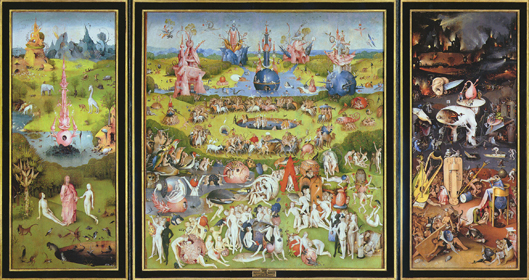/
EN
| Hieronymus Bosch The Garden of Earthly Delights Approx. 1500 Museo Nacional del Prado Madrid, Spain |
|
Rights (Photo / Work):
CC0 // Wikipedia List of sources: |
The left panel of the triptych[1] depicts the garden of Eden, the central panel the garden of earthly delights and the right panel portrays the torments of damnation[2]. The three scenes of the inner triptych were painted on top of each other. In the left panel God appears with Adam and Eve and is one of the few dressed figures; the majority of them is undressed. Genitals or the pubic hair of both male and female figures are depicted explicitely or in a naturalistic way. Apparently, the representation of the sexual organ was still tabooed in the Renaissance because it was either left out, covered up or depicted incompletely except for the "ostentatio genitalium" - the artistic expression of Christ's male genitals[3]. An interesting interpretation concerning the central panel derives from Wilhelm Fraenger[4], who refered to the image as liberated paradise of love, where people devoted themselves to eroticism and lustful sexuality. However, other art historians disaccorded with this theory. They argued that the otherworldly paradise, like hell, was part of an essential religious reality and that the thought of a sexual liberation derived from the 20th century rather than the Renaissance[5]. It was said that even Bosh distanced himself from the "desire for an otherworldly paradise which was based on a fantasy"[6].
Biography: http://de.wikipedia.org/wiki/Hieronymus_Bosch (Translation: C. Wilhelm) |



